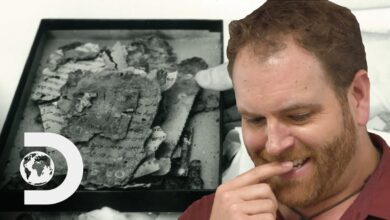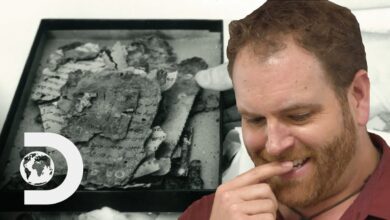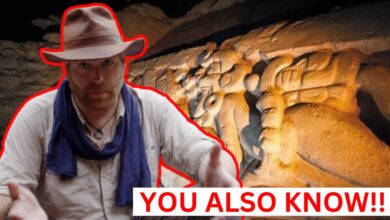Intrusive Burial Found Inside Egyptian Noble’s Tomb! | Expedition Unknown
Intrusive Burial Found Inside Egyptian Noble’s Tomb! | Expedition Unknown

This passage takes us deep into the heart of ancient Egypt’s collapse during the First Intermediate Period, when the centralized power of the Old Kingdom pharaohs gave way to regional rulers and chaos. The investigation focuses on the tomb of Ani, an important figure during this tumultuous time, and his inscriptions which provide a glimpse into the societal breakdown.
Tomb of Ani – A Dignitary’s Self-Description:
Ani’s tomb, located near Luxor, offers fascinating insight into the societal and political changes during the decline of Egypt’s Old Kingdom. Ani, a regional ruler with several impressive titles—including Governor, Royal Seal Bearer, and Regional Ruler—boasts that he is “the beginning of men and the end of men,” a phrase that speaks to his elevated sense of self-importance and power. He claims that no one like him was ever born nor will be, a common tactic among individuals of his rank to assert their unchallenged authority.
However, Ani’s tomb also tells a darker story of the country’s decline. The walls of his tomb highlight a severe crisis where Upper Egypt was suffering from famine. Ani describes a time of starvation so dire that people were driven to extreme measures, such as eating their own children—a metaphor for how the society had descended into desperation and cannibalism due to food scarcity.
The Great Famine and Drought:
The First Intermediate Period (around 2200 BCE) saw the Old Kingdom collapse, and archaeological evidence supports the idea of a decades-long drought during this time. Sediment tests have confirmed that parts of the Nile region were bone dry, exacerbating food shortages. This period of drought coincided with the rise of regional rulers like Ani, who were vying for power, and the lack of centralized control by the Pharaoh. With food in short supply, local rulers controlled what little resources remained, creating a volatile and dangerous situation that made conflict nearly inevitable.
As these regional leaders, like Ani, fought to maintain control, they resorted to warfare, leading to violent struggles between rival factions. In Ani’s tomb, he recounts battles with enemy coalitions, painting a picture of a fragmented Egypt where chaos and internal strife were commonplace.
The Mysterious Burial and Intrusions:
The excavation shifts focus to a tomb in Saqqara, which belonged to Hu, a noble during the reign of Pharaoh Merneptah. The tomb had previously been looted and re-used, a common practice in ancient Egypt. The archaeologists discover a mud brick wall that had been added later, indicating that the tomb was re-purposed shortly after its initial use.
As they dig further, they uncover an intrusive burial—a body that was placed in the tomb after the original owner had already been interred. This practice of “intrusive burials” was not uncommon. When tombs were reused, later generations would discard the original occupant and place their own deceased relatives in the tomb, sometimes without regard for the previous burial’s sanctity.
This intrusive burial is a reflection of the desperation of later generations. They would bury their dead in an existing tomb and surround them with offerings and spells to ensure a safe passage to the afterlife—recycling the sacred space for their own needs.
The Mummy of Hu’s Tomb:
As the team continues their excavation, they discover the remains of an Old Kingdom mummy placed in a disturbed burial. This individual was likely buried after Hu, evidenced by the fact that his body was placed directly on top of the original tomb occupant. The mummy, poorly preserved but still recognizable, shows signs of basic mummification techniques—far less sophisticated than the later practices of the New Kingdom.
It is a powerful moment for the archaeologists as they literally come face to face with the past, as the burial site and its unsettling contents reflect the decay of a once-powerful civilization. The discovery of the mummy’s skull further personalizes the history—this was an individual who lived, died, and was once part of the thriving Old Kingdom society, now reduced to dust and bones in a tomb reappropriated for a new generation’s needs.
Tomb Desecration and the End of the Old Kingdom:
The idea that desperate individuals would break into tombs and destroy them to bury their loved ones speaks volumes about the collapse of social order during this time. The Old Kingdom’s reverence for the afterlife, the pharaohs’ divine power, and the sacredness of tombs were all cast aside in the face of crisis. As Egypt descended into chaos, even the sacred burial spaces were no longer safe from desecration. This represents the end of an era, when tradition was no longer respected, and individuals were willing to take extreme measures to secure the afterlife for themselves and their families.
The Larger Picture:
The discoveries in these tombs illustrate how climate change, famine, and political instability led to the decline of the Old Kingdom. What once was a civilization united under the pharaohs’ absolute rule had fragmented into warring factions of regional leaders. The tombs—once symbols of Egypt’s grand religious and political power—became sites of desperation, where tomb raiders and desperate families fought for a place in the afterlife.
The notion that later generations could desecrate the tombs of their ancestors shows how far Egypt had fallen from its once-glorious peak. The collapse of the Old Kingdom wasn’t just a political and economic collapse but a collapse of traditions, values, and respect for the divine.
Conclusion:
The First Intermediate Period in Egypt represents a dark age in the country’s long and storied history. As the central authority of the pharaohs crumbled, famine, drought, and internal strife plagued the land. The tombs of the time, once hallowed and sacred, became markers of this collapse of order, with people breaking into and repurposing tombs to create an afterlife for their own loved ones. The bodies found in these tombs—such as those of Hu and the later intrusive burial—offer us a poignant glimpse into the desperation and chaos of a civilization in crisis.








